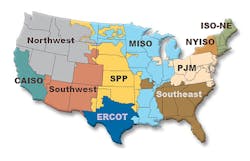Evaluating Demand Response Programs for Foundries
Have you heard that some metalcasters actually are paid by an electric utility for not using electricity? These operations probably enrolled in a special program called Demand Response (DR). How much and how often a foundry may be paid depends on the details of the DR program they joined. Following here is a review the pros and cons of this decidedly abnormal behavior of the monopolistic electric utility business.
What is Demand Response?
According to the U.S. Department of Energy, “Demand Response is an electricity tariff or program established to motivate changes in electric use by end-use customers, designed to induce lower electricity use typically at times of high market prices or when grid reliability is jeopardized.” The focus here is on using DR to help improve grid reliability.
During times of stress on the grid, demand for electricity may exceed available generation. Grid operators can easily control the amount of electric generation (supply), but they have few methods to control Demand besides disconnecting the customer. Not a preferred solution.Utilities wanted to find some way to have significant electric demand voluntarily reduced, when required. Demand Response programs were created to incentivize and reward customers who can reduce large amounts of demand on short notice.
Each DR program is different, and typically offered by the Independent System Operator (ISO) for a region. Not all ISOs offer a Demand Response program. The Pennsylvania, Jersey and Maryland ISO (PJM) is home to many foundries and they offer a DR program, so we’ll refer to that example for some additional details.
Currently, DR programs are available in these ISO territories:
• California (CAISO)
• New England (ISO-NE)
• New York (NYISO)
• Pennsylvania, New Jersey, Maryland (PJM)
• Texas (ERCOT)
The common element of each program is a financial incentive for a foundry or diecaster to reduce the amount of electricity it uses (but only when requested by the ISO!) PJM relies on a group of Curtailment Service Providers (CSP) to market and administer its DR program. The CSPs accept applications to the DR program, assess the capabilities of each applicant to reduce demand, and may even help to develop a Reduction Action Plan. Then, a metalcaster signs a contractual commitment with the CSP to become a program participant. Payment details are included in the contract.
The CSP may install metering equipment to validate with the utility that the metalcaster participated in an event and how much it reduced its Demand. This helps ensure the foundry is paid properly for its participation.
The CSP also will oversee test events. Part of the contractual obligation is to agree to periodic tests of its capability to reduce its load by the amount promised in the contract. Duration of the test is determined by the utility, but it may last for hours.
“Events” are declared by the utility when it may need a participating foundry to reduce its Demand. The response for a given event is required within a certain period of time. A foundry can decline to participate, but that may disqualify it from further participation in the DR program. There has to be a good reason for non-participation.
It appears that PJM currently requires a foundry’s response within 30 minutes. Event duration can last for hours, days, or longer. Typically there is a maximum number of such “events” (around six), that can be declared during any given year.
Is a Demand Response program right for you?
In my opinion, the utility is by far the greater beneficiary of any DR arrangement. Once it gets the contracted load reduction from a foundry the electricity supplier is off to address its next crisis to stabilize the grid. It’s up to the foundry and its resources to figure out if and how to continue operations.
Many foundry owners avoid any such disruptions to their operations. No amount of enticement warrants the problems that can result from interrupting the process flows within the foundry.
Yet, some owners welcome the payments as an additional revenue stream, if the DR program has large enough incentives. Historically, few actual “events” have been declared, so foundry disruptions have been minimized. Be aware that the number of declared “events” very well may increase in the future.
Declaring a Demand Response Event is one of the last-ditch efforts available to a utility. The grid is in serious trouble and rolling blackouts may be expected. Getting notified of an imminent DR Event may give a foundry the warning it needs to start backup generators or additional onsite generation, so it can continue production. The operational savings from such a smooth transition would likely dwarf any DR incentives that the foundry may receive.
On-site electric generation has evolved from simply providing emergency backup power. Running longer, these assets can power much, if not all, of the foundry – and also reduce how much power it needs from the grid each month. This can provide significant cost savings on the electric bill. Having enough of its own generation can support a foundry’s participation in available DR programs, enabling even greater savings.
Brian Reinke, president of TDI Consulting, is an energy-cost saving consultant. Contact him at [email protected]
About the Author
Brian Reinke
President
Brian Reinke, president of TDI Energy Solutions, is an energy-cost saving consultant. Contact him at 630-343-0971.

